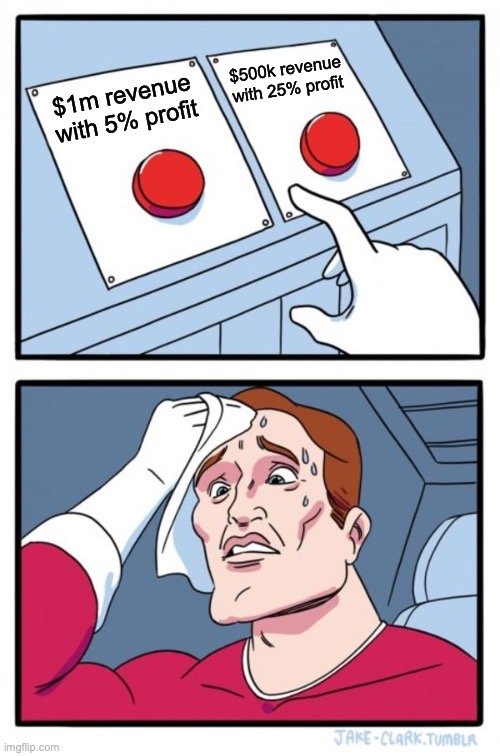Attract Better Customers with Specific Marketing
Business owners are often afraid to “niche down” and get more specific about what their businesses do. There’s a misconception that increased specificity makes the lead capture net smaller. It may sound illogical at first, but getting specific helps your customers and allows you to charge more for your products or services.
If you’re running a SaaS startup, would you rather hire “a leading digital marketing agency,” or “a digital marketing agency that has helped 40+ SaaS providers go from $100K to $1M in annual revenue?” The choice is obvious!
The “leading digital marketing agency” could likely help get attention on your business, but the agency with SaaS expertise will get a better result and satisfy more of your needs.
Getting specific—and all its accompanying benefits—comes down to a single word: positioning.
Don’t be afraid to “niche down”
There’s only one pre-sale currency that matters to a business owner: leads. We hear this from our customers all the time: “We need more leads.” Sure, there’s a mathematical reality that getting more specific decreases the pool of potential buyers, but it’s nonsense to believe that’s bad for your business.
“You see these? These are the news leads. These are the Glengarry leads. To you, these are gold. You do not get these, because to give them to you would be throwing them away.”
Think about it this way: Would you rather run a company that does $1M in gross revenue with a 5% profit margin? Or a company that makes $500K in gross revenue with a 25% profit margin? I don’t know about you, but I’d rather make $125K in profit than eke out $50K from $1M in revenue (which would probably require doing a lot more work, too).
The same math applies here to leads and prospects. It’s better to speak to a smaller pool of likely buyers than to a huge pool of unlikely buyers. I’d take a 50% conversion rate over a 5% rate any day, even if the 5% rate pool is dramatically larger.
Lack of specificity is a key driver of low conversion rates in large pools. If you’re talking to everyone, you’re talking to no one. It’s the classic joke of the target persona: “I want to speak to everyone from age 18 to 65, male or female, in every state of the U.S.” That is NOT a persona!
In fact, Ellis had a great comment as I was writing this article: “Businesses are afraid that if they're specific, it will scare away ‘everyone else,’ but in fact by trying to be for ‘everyone else’ they scare their target audience away.”
Remember those Chevrolet “like a rock” truck commercials from the 1990s? You think they were trying to reach soccer moms by showing trucks driving off-road on construction sites? Of course not!
If you want higher conversion and greater interest, then you must appeal to the people who care most about whatever you’re offering.
5% of $1M is $50K. 25% of $500K is $125K. I’d rather press the button on the right.
Specificity gives people a reason to care
I spend hours researching any purchase above $100. The more expensive it is, the more time I take learning about the thing I’m going to buy. For example, a few years ago I started thinking, “How many pairs of shoes have I thrown in the trash? What did people do before shoes were disposable? Are there shoes that last longer than a few months or a couple of years?”
That’s when I learned about Allen Edmonds shoes (no, they’re not sponsoring this but they are welcome to). They’re designed and made in America using high-quality leathers. After you wear out the sole, you can send them back to be recrafted, a process that preserves most of the shoe material and replaces the parts that wear out, like the sole and heel base. Allen Edmonds has been in business since 1922, serving customers who care about long-lasting, good-looking American footwear. This is a huge contrast to all the cheap, short-lived, glued-together shoes I’ve been buying my whole life.
Are you hearing me parrot specifics about the brand, the product, and the competition?
As seen on the Allen Edmonds website: a normal, everyday person smoking a cigar, while wearing his leather shoes and a khaki suit with shorts, while standing next to his Ferrari.
Everything I’ve mentioned is positioning. Allen Edmonds is a shoe brand that I didn’t care about until I started learning about them. Now I own four pairs of their shoes and I’m a happy customer. I meet other people who buy handmade shoes and we talk about it because we share similar values. Before I knew about Allen Edmonds, I haaaated spending more than $50 on a pair of shoes. Now I’m spending $200-300 per pair because I know they’ll last me years and I feel good about what I’m buying.
Allen Edmonds has done a great job positioning themselves as a shoe brand for men who care about quality, materials, craftsmanship, reusability, and more. I don’t care how much they cost and neither does my miserly wife. We both know that we’re paying for something that’s worth the hard-earned money. We have a reason to spend that much on shoes.
Without specificity, who cares?
Allen Edmonds’ positioning gave me a reason to care about shoes just like Apple’s positioning gave me a reason to stop caring about their laptops for several years … until they released the 16” MacBook Pro and directly addressed my years-long grumbling about their products.
Before the 16” MacBook Pro came out, Apple was positioning themselves entirely around design and beauty—two words that computer performance junkies like me don’t care about. They used words like “thinnest” and “lightest,” which are not specific terms and don’t address the needs of a professional user. Apple was missing the mark because pros don’t care about “thin.” Pros want performance, and high-performance machines generate heat. Heat is a big problem for a thin chassis.
Apple had practically lost me and millions of other professionals over the years because their computers were positioned as “the fastest Macs ever.” Professionals want objective speed, not comparative speed against a previous model. It’s like saying, “The fastest Nissan Sentra ever” when you need Tesla-level speed.
Apple had gone so far in the wrong direction, they ended up doing something they’d never done before: invited the most technical Apple journalists to their headquarters to apologize and admit they weren’t serving the professional market. The situation was so bad, many of us pro users were moving to Windows machines with expensive, beefy dedicated graphics and processors with high core counts.
Even I, a hardcore Mac user since 1984, had purchased a Windows laptop with a discrete graphics card for my video work. It had all the ports and I/O I needed, but it was far from perfect. It had a small screen, battery life sucked, and the machine got hot and loud under high load. The upside: I could do my video work on the go, even if it was just for two hours on battery. I even got into the expensive world of external GPUs to get extra horsepower over Thunderbolt 3.
It wasn’t until October 2021 (five years after I bought that Windows laptop) that Apple announced their new M1 Pro and M1 Max lineup. They specifically called out all the issues pro users thought they’d had given up on: more ports (including an SD card reader), a thicker chassis, a bigger brighter screen, and highly scalable, beastly performance.
Millions of nerds around the world cheered at the product announcement. Even Apple’s staunchest critics were singing their praises because these machines are objectively and legitimately powerful. Apple knew they hit the bullseye, and it’s reflected in the copy at the top of their product webpage:
“With the blazing-fast M1 Pro or M1 Max chip — the first Apple silicon designed for pros — you get groundbreaking performance and amazing battery life.” Sure, there’s a little BS in here, but pros want blazing-fast, groundbreaking performance and amazing battery life.
“Add to that a stunning Liquid Retina XDR display, the best camera and audio ever in a Mac notebook, and all the ports you need.” Some more BS, but pros want a good display and lots of ports.
“The first notebook of its kind, this MacBook Pro is a beast.” They’re giving us a beast and it’s “the first of its kind” (whatever that means).
“More CPU cores, more GPU cores, and more unified memory.” Yes, yes, yes.
“Up to 200GB/s memory bandwidth” and “Up to 20 streams of 4K ProRes video playback.” Okay, okay! This machine is fast!
With specs like these, of course a pro would buy it! They’ve positioned their product to be exactly what we’ve needed for years. Anyone who’s shopped the Windows laptop world knows you can get great performance or amazing battery life, but not in the same machine—until now. And, if you read between the lines, they’re kind of positioning their new laptops against their previous generation, too-thin, not-powerful-enough laptops.
Before Allen Edmonds, I didn’t care at all about shoes. Before the new MacBook Pro, I stopped caring about Apple’s laptops. Now I spend hundreds of dollars on a pair of shoes and thousands of dollars on a high-end laptop and I feel good about it.
How are you positioning your company?
Everyone has biases—even you. We also have needs. And when it comes down to how or what to buy, we have criteria we use to select something.
If the thing we’re purchasing doesn’t appeal to a bias or fulfill a specific need, then the selection criteria comes down to some arbitrary attribute, like price or color. When consumers have nothing to care about, they just get the cheapest thing that “fits the bill.”
Considering all this, how are you positioning your business? When you look at your website, read your blog content, and send out newsletters, you might think, “Yeah, this is what I should be doing.” But do you address the specific needs and desires of your potential customers? Or are you just writing about yourself and giving people nothing specific to care about? Or maybe you have “featuritis.”
If you’d like some help getting this figured out, let me know. This is literally what my business partner, Ellis, and I do for a living. We also host free, no-obligation virtual office hours on Fridays. If you join us, we’ll look through your website and help you see what you’re not seeing. Then we’ll give you tips on how to fix it.



